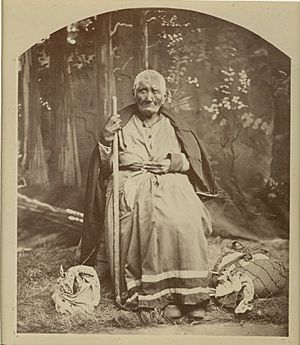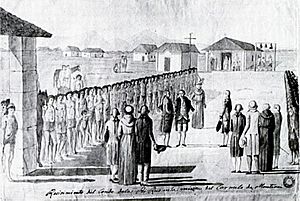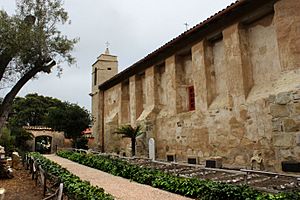Rumsen people facts for kids

The Rumsen are one of eight groups of the Ohlone people. The Ohlone are an Native American people from California. The Rumsen were also known as Rumsien, San Carlos Costanoan, or Carmeleno. Their traditional lands were along the coast and inland in what is now Monterey County, California. This area includes the Monterey Peninsula.
Today, the Rumsen people, like other Ohlone groups, are not officially recognized by the United States government. However, they continue to keep their culture alive. They also maintain their community in central California. The Rumsen signed a treaty with the U.S. government on May 13, 1851. This was called the Treaty of Camp Belt. The treaty was later hidden for 30 years. During this time, the government checked if the lands given to the tribes had gold.
Rumsen Lands and Homes
The Rumsen people historically spoke a common language called Rumsen. This language was spoken from the Pajaro River down to Point Sur. It was also spoken along the lower parts of the Pajaro, Salinas, and Carmel Rivers. This region includes the modern cities of Salinas, Monterey, and Carmel Valley.
When the Spanish arrived, the Rumsen tribe lived in the lower Carmel River Valley. They also lived on the nearby Monterey Peninsula. About 400 to 500 Rumsen people lived in at least five villages. One important village was called "Tucutnut". It was located about three miles up the Carmel River from its mouth. This village was the largest home for the Rumsen people.
Rumsen History and Spanish Contact
The Rumsen were the first Costanoan people seen by Spanish explorers. This happened when Sebastián Vizcaíno reached Monterey in 1602. After this first meeting, large Spanish ships called Manila galleons sometimes visited Monterey Bay. This was between 1602 and 1769.
During the time of the Spanish missions in California, the lives of the Rumsen people changed greatly. The Spanish built the Mission San Carlos Borroméo de Carmelo and the Monterey Presidio in their territory. Many Rumsen people were baptized between 1771 and 1808. After baptism, they were often forced to live at the mission village. They also had to work on the mission's farms.
They were taught the Catholic faith as neophytes, also known as Mission Indians. This continued until the missions were closed by the Mexican Government in 1834. This closing was called "secularization." Some Rumsen people from Mission San Carlos were given plots of land after secularization. However, these lands were later taken from them during the Rancho Period.
The Esselen Nation people have close ties with the Rumsen Ohlone. These connections grew through living together at the missions and through marriages between their people.
Rumsen Language and Cultural Revival
Different forms of the Rumsen language were spoken by four separate local tribes. These included the Rumsen people themselves. There were also the Ensen from the Salinas area. The Calendaruc lived along the central Monterey Bay shoreline. The Sargentaruc lived along the Big Sur Coast.
The Rumsen language group's land was bordered by Monterey Bay and the Pacific Ocean to the west. To the north were the Awaswas Ohlone. The Mutsun Ohlone were to the east. The Chalon Ohlone were to the southeast. The Esselen people were to the south.
Linda Yamane is an Ohlone scholar and basket weaver. She is a descendant of the Rumsen Ohlone. Linda has spent over 30 years researching and bringing back Rumsen language, stories, songs, and basket weaving. She also works to revive other Ohlone cultural traditions.



